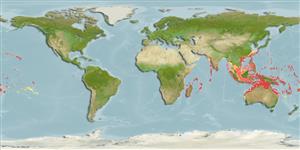Environment: milieu / climate zone / depth range / distribution range
Ekologi
laut berasosiasi dengan karang; kisaran kedalaman 4 - 100 m (Ref. 6390). Tropical; 30°N - 33°S, 33°E - 134°W (Ref. 5222)
Indo-Pacific: Kenya to Delagoa Bay, Mozambique, eastward to the Tuamoto Islands, north to the Ryukyu Islands, south to Queensland, Australia and including most islands of the Indian Ocean and of western and central Pacific. Unknown in the Red Sea and Persian Gulf. Misidentified as Plectropomus maculatus by some authors (Ref. 6448, 6892).
Length at first maturity / Size / Weight / umur
Maturity: Lm ?, range 60 - ? cm
Max length : 125 cm TL jantan/; (Ref. 30573); common length : 84.0 cm SL jantan/; (Ref. 37816); Berat maksimum terpublikasi: 24.2 kg (Ref. 40637)
Duri punggung (Keseluruhan (total)): 7 - 8; duri punggung lunak (Keseluruhan (total)): 10-12; Duri dubur 3; Sirip dubur lunak: 8.
A voracious piscivore inhabiting coral-rich areas of lagoon and seaward reefs. Encountered most frequently in channels and outer shelf reefs. Migrate over short distances to spawn, forming large aggregations, maybe 1 or 2 per reef (Ref. 6390). Feeds mostly on fishes, and occasionally on crustaceans (Ref. 9710). The prey comprises a variety of large reef fishes, including groupers, and this diet of large fishes is responsible for the high concentrations of ciguatera toxins. Juveniles may mimic the pufferfish Canthigaster valentini. Usually wary (Ref. 9710). The young have a demersal existence in shallow water in reef habitats, especially around coral rubble (Ref. 27259). They feed on small fish and invertebrates such as crustaceans and squid (Ref. 27261). Eggs float just below the surface (Ref. 6390). The pelagic larvae are found in habitats similar to those of the adults (Ref. 27260). An excellent table fish (Ref. 6390).
Heemstra, P.C. and J.E. Randall, 1993. FAO Species Catalogue. Vol. 16. Groupers of the world (family Serranidae, subfamily Epinephelinae). An annotated and illustrated catalogue of the grouper, rockcod, hind, coral grouper and lyretail species known to date. Rome: FAO. FAO Fish. Synop. 125(16):382 p. (Ref. 5222)
Status IUCN Red List (Ref. 130435)
ancaman kepada manusia
Reports of ciguatera poisoning (Ref. 1602)
penggunaan manusia
Perikanan: komersial; Ikan buruan: ya
informasi lanjut
AcuanBudidaya airprofil budidaya airStrainGenetikaElectrophoresesDiturunkanPenyakit-penyakitPengolahanNutrientsMass conversion
Alat, peralatan
laporan khas
muat turun XML
Sumber internet
Estimates based on models
Preferred temperature (Ref.
123201): 25.5 - 28.9, mean 27.6 °C (based on 276 cells).
Phylogenetic diversity index (Ref.
82804): PD
50 = 0.5078 [Uniqueness, from 0.5 = low to 2.0 = high].
Bayesian length-weight: a=0.01000 (0.00609 - 0.01643), b=3.07 (2.93 - 3.21), in cm total length, based on LWR estimates for this species & (Sub)family-body (Ref.
93245).
Trophic level (Ref.
69278): 4.1 ±0.57 se; based on food items.
Daya lenting (Ref.
120179): sedang, Waktu penggandaan populasi minimum 1.4 - 4.4 tahun (Preliminary K or Fecundity.).
Fishing Vulnerability (Ref.
59153): High vulnerability (61 of 100).
Nutrients (Ref.
124155): Calcium = 20.8 [13.2, 35.1] mg/100g; Iron = 0.482 [0.266, 0.777] mg/100g; Protein = 18.7 [16.9, 20.3] %; Omega3 = 0.133 [0.090, 0.206] g/100g; Selenium = 47.6 [28.5, 84.4] μg/100g; VitaminA = 76.1 [28.9, 230.2] μg/100g; Zinc = 0.698 [0.493, 0.988] mg/100g (wet weight);
